Cambridge AS Design & Technology students now have an “extended response” question in their examination. This article lists possible topics to help you prepare for this question.
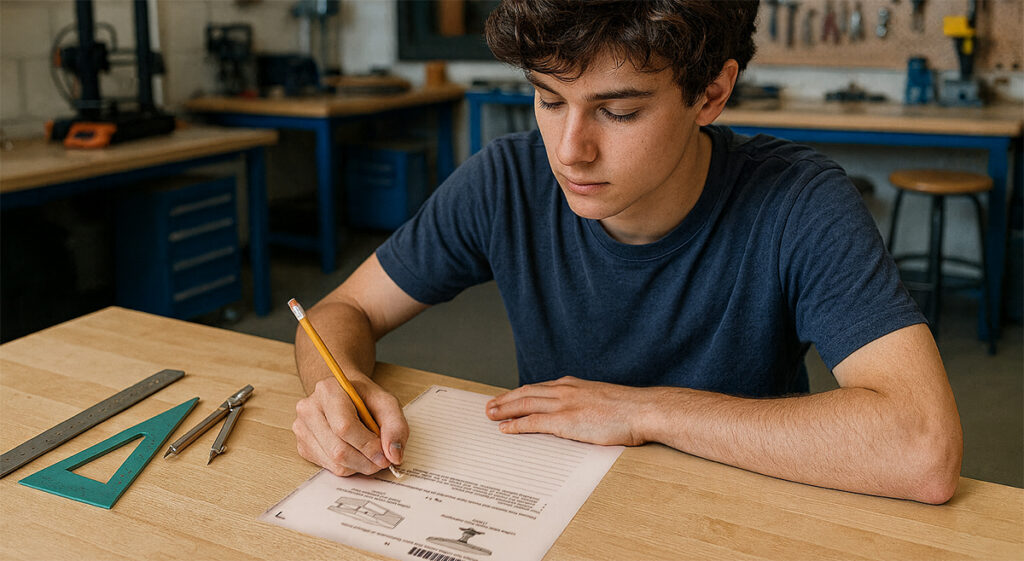
IMPORTANT TIPS
- Write in full sentences, with paragraphs
- Ensure you include appropriate examples (these might be of specific products, designers, design movements etc)
- Ensure you link your discussion to wider issues in design & technology (including cultural, economic, environmental, and social factors)
Sample Extended Response questions (AS)
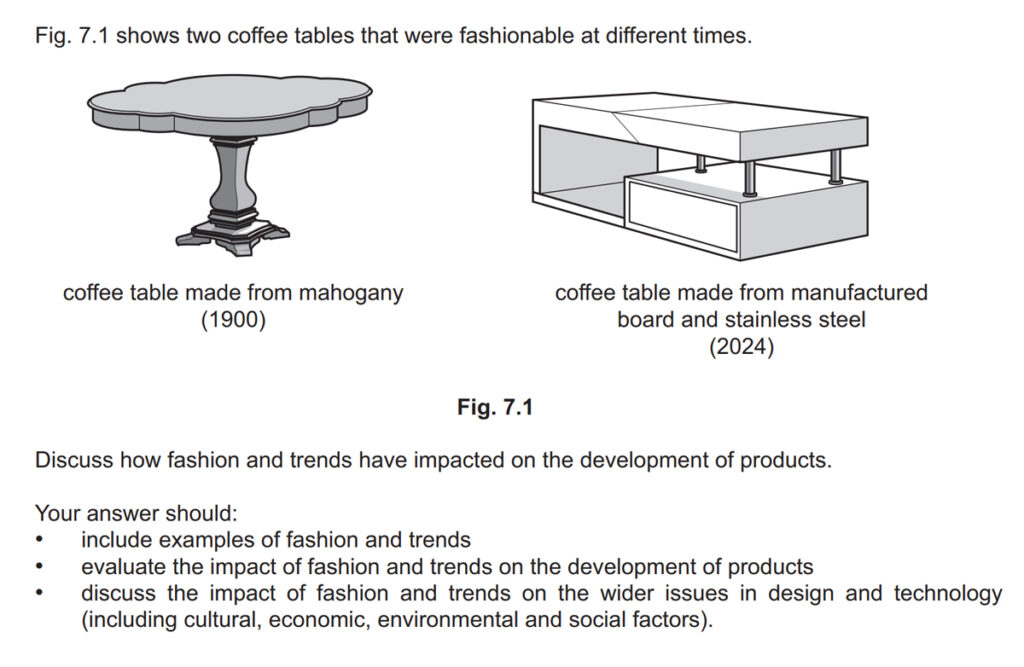
Note: Revise fashion and trends here.
Responses may include some of the following ideas, but all valid
material must be credited.
- Reference to design movements such as Bauhaus
Streamlining, Minimalism, Modernism and Postmodernism - Fashion and trends provide a driving force for designers and
manufacturers that can have a huge impact on the volume of
sales - People like to be seen with products that are in fashion and
follow the latest trends, so this increases sales - Designers and manufacturers generally seek a high volume of
sales, as this reduces production costs and increase profit - A new trend can increase sales, even though the product it is
replacing is still perfectly serviceable E.g. new mobile phones - Older, or out of fashion, products can provide a cheaper
alternative that can be marketed in less well-developed
countries - Peer pressure makes new products very desirable as people
want to be seen with the latest product - Products can be designed with a limited lifespan as the
designers know they will be replaced with a the latest ‘fashion’
in a relatively short period of time - Continually replacing products to follow the latest fashion can
be expensive but also creates recycling issues if the old product
is not designed to be recycled - Designers look for emerging fashions and trends so that their
products hit the market when they are most desirable - Do designers follow fashion and trends or dictate the latest
fashion and trend? - Products can be designed to be adaptable, for example covers
and parts be replaced, so that they can be adapted to follow the
latest trends - Examples of products that might be given include mobile
phones, clothing, vehicles, houses…
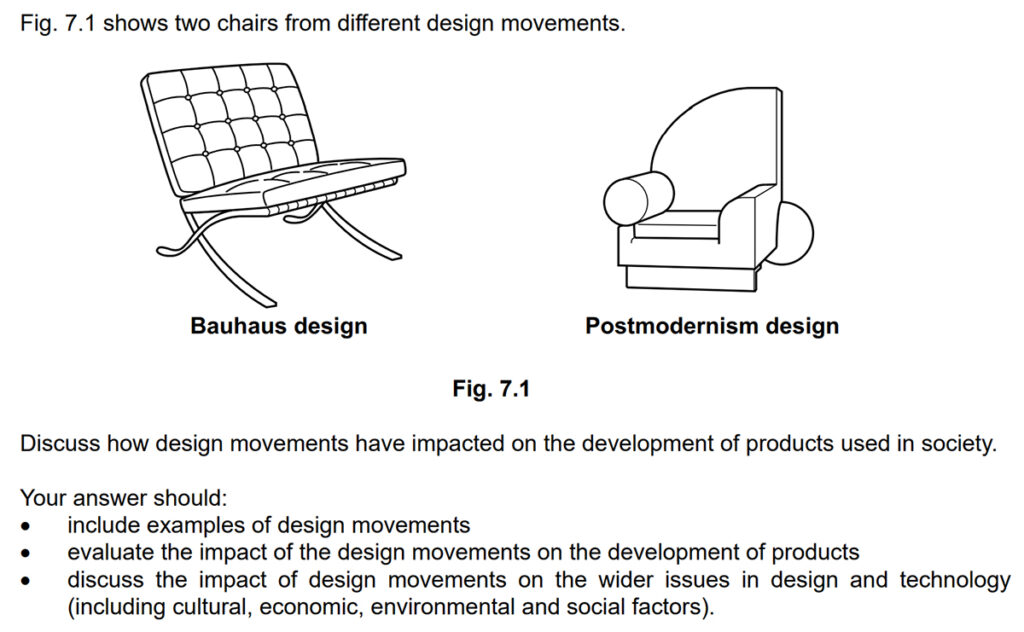
Note: Revise art & design movements here.
Responses may include some of the following ideas, but all valid material
must be credited.
- Reference to design movements such as Bauhaus Streamlining,
Minimalism, Modernism and Postmodernism - Characteristics of Bauhaus products, such as simple, easy to mass
produce, materials used in their honest and natural form and not altered
and streamlined aesthetics - Characteristics of postmodernist products such as bold colours and
outrageous patterns, transforms the ordinary and everyday, form does
not follow function, turns cheap materials into expensive objects, use of
humour and irony - Postmodernism principles have influenced designers to reinvent existing
products by interpreting them in a modern way, redesigning them with
more modern materials and technologies. Postmodernism, encourages
designers to break away from the rules, to design something that catches
the attention rather than blends into the background - Minimalism has influenced the design of products with its ‘less is more’
principle, by making design simple, stripping it down to the essentials,
removing unnecessary components or features. Minimalist designs are
good for the environment and can cost less as they focus only on the
essentials using fewer resources - Modernism has influenced the design of products by promoting sleek,
clean lines and eliminating decorative additions only used for the
embellishment of the product. It results in the design of products that
prioritise practicality and usefulness over beauty and excess. Modernism
encourages designers to break away from the conventions of the past, to
break stereotypes and to experiment - Technology has also had an impact on design movements. The current Maker design movement is a reaction to rapid technologising. It encourages a do-it-yourself focus and desire for authenticity, in the impersonal high-tech world. It is a cultural trend that places value on the individual’s ability to be a creator of things as a well as a consumer of things
- Design movements can be a reflection of the society that the designer
lives in or a reaction to the society the designer lives in. The Arts and
Crafts design movement was an international design movement that
reacted against mass production, both the low quality of design and
the demeaning conditions in which the products were mass produced.
The movement started as a reaction to the Industrial Revolution and
promoted the use of natural materials and the importance of decoration
and beauty - Examples of how products are impacted by a design movement, such as
furniture, architecture, electric products
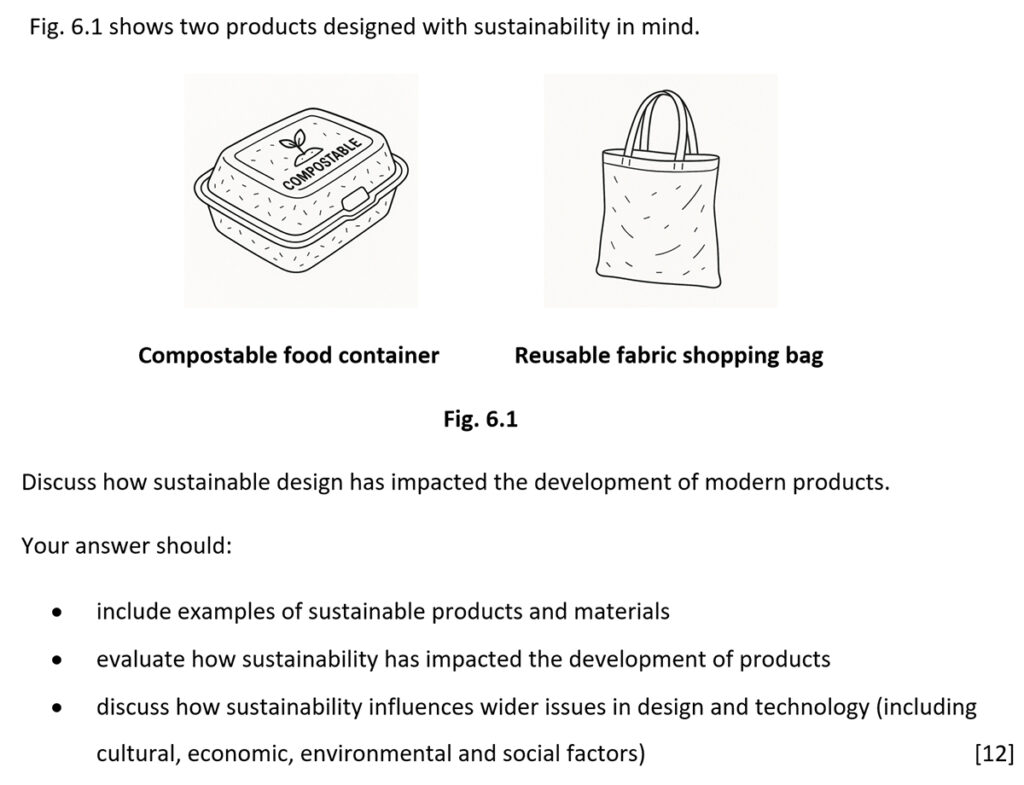
Note: Revise issues relating to sustainability in product design here.
Responses may include some of the following ideas, but all valid material
must be credited:
- Prioritising sustainability has led to material innovation, such as biodegradable plastics, recycled materials, plant-based alternatives, which has an impact upon the products that use these, and can spur creative solutions
- Has impacted product longevity, with more people prioritising products that are durable and able to be repaired easily, rather than a disposable culture with products designed for single use, or planned obsolescence (example – single use plastic bag use now prohibited in NZ, with reusable fabric bags preferred instead)
- More emphasis on end-of-life considerations – with designers forced to consider compostability, recyclability, biodegradability, ease of disassembly, reuse, and material recovery
- Greater emphasis on local and sustainable materials that use ethical manufacturing and lead to a reduced carbon footprint
- A focus on sustainability can make materials and manufacturing more expensive and hence might not be financially viable for some companies
- Provides promotional opportunities, targeting environmentally conscious consumers (so not just good for the environment, but can be good for business)
- Greater emphasis on minimising waste – has impacted the way many companies approach packaging – less plastic bubble wrap (now wool-based alternatives etc)
- Sometimes government regulations drive change – forcing manufacturers to get on board with sustainability goals
- A shifting consumer awareness can lead to customers demanding sustainable options, leading companies to feel obligated to embrace these initiatives
- Sometimes sustainable materials are more expensive, making products inaccessible for certain sectors of the population
- Examples: modern cleaning products use concentrated refills, so reduced packaging waste; Adidas ocean plastic shoes are made from 50% recycled plastic waste found at beaches; energy efficient LED lighting; IKEA flat-pack furniture reducing shipping costs and prioritising renewable materials
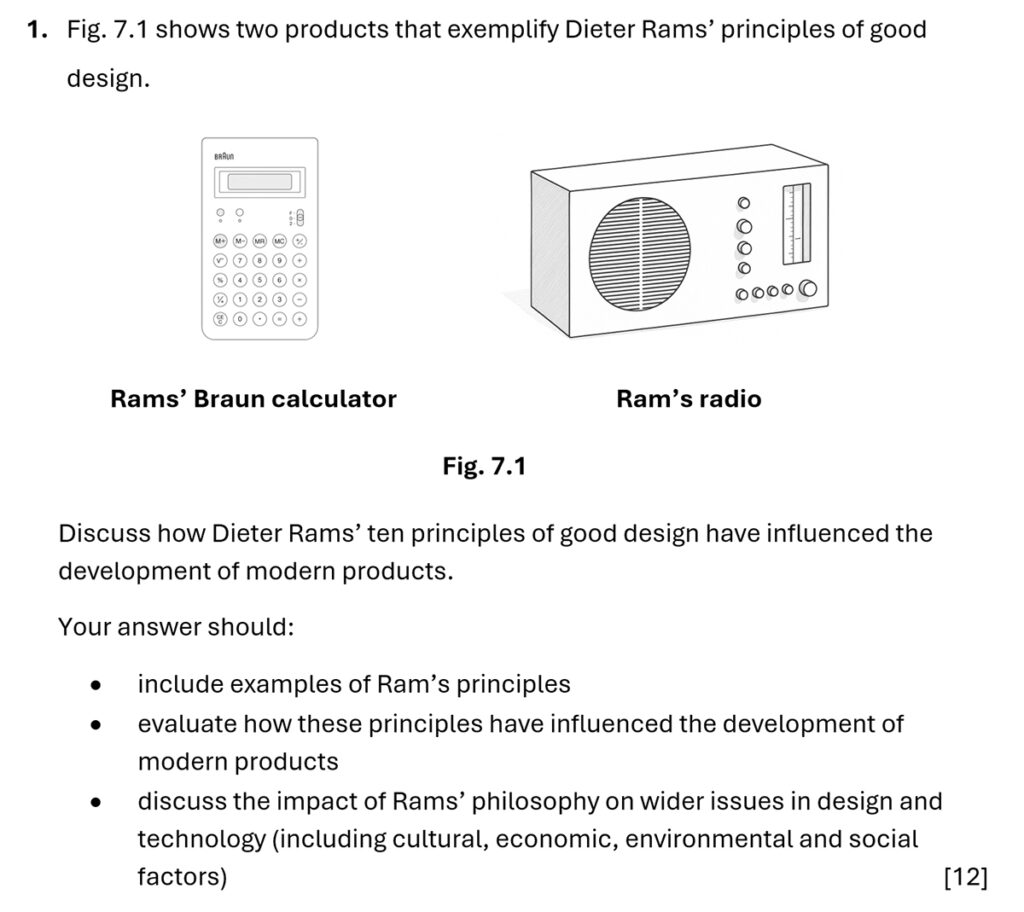
Note: Revise Dieter Rams’ principles of good design here.
Responses may include some of the following ideas, but all valid material
must be credited:
- “Good design is as little design as possible” – supports idea that “less is more” – helping to support the shift from ornamental design to functional minimalism. Examples: Apple iPhone, which echoes the minimalist interfaces used in Rams’ design. Also links to his idea that “Good design is thorough down to the last detail” where everything is intentional, rather than frivolous. This can lead to more efficient and cost effective manufacturing processes, ensuring products are accessible to a wider segment of society.
- “Good design makes a produce understandable” – helped to encourage intuitive design – products that are easy for the user to operate without complex instructions – further increasing the accessibility of the product, so it can be used by greater numbers of people. For example, those who don’t speak the same language can still operate a product if the design is intuitive. Examples: Spotify interface (clear visual hierarchy that guides users to relevant content). Important to note there can a tension between minimalism and accessibility – if the product is absent of too many details it can be harder to understand.
- “Good design is long-lasting” – encourages durable products, rather than a single-use, throwaway culture. (Example of a long-lasting product – a Swiss army knife that might last someone’s whole life.) This also ties to ideas about quality and environmental responsibility (“Good design is sustainable”). Supports viewpoints that are popular in modern times, with many people liking to perceive themselves as acting in an environmentally friendly way and manufacturers wishing to present themselves as eco-conscious brands. Leads to a reduction in waste overall and the creation of higher quality, resilient designs. (However, these might be more expensive, and hence out of price range of some consumers, so a balance is needed.)
- “Good design is honest” – causes people to question the use of decorative laminates, such as Milamine on table tops, as it hides the true material and creates a deceptive illusion about the quality of the product. However, others feel there is no problem with this.
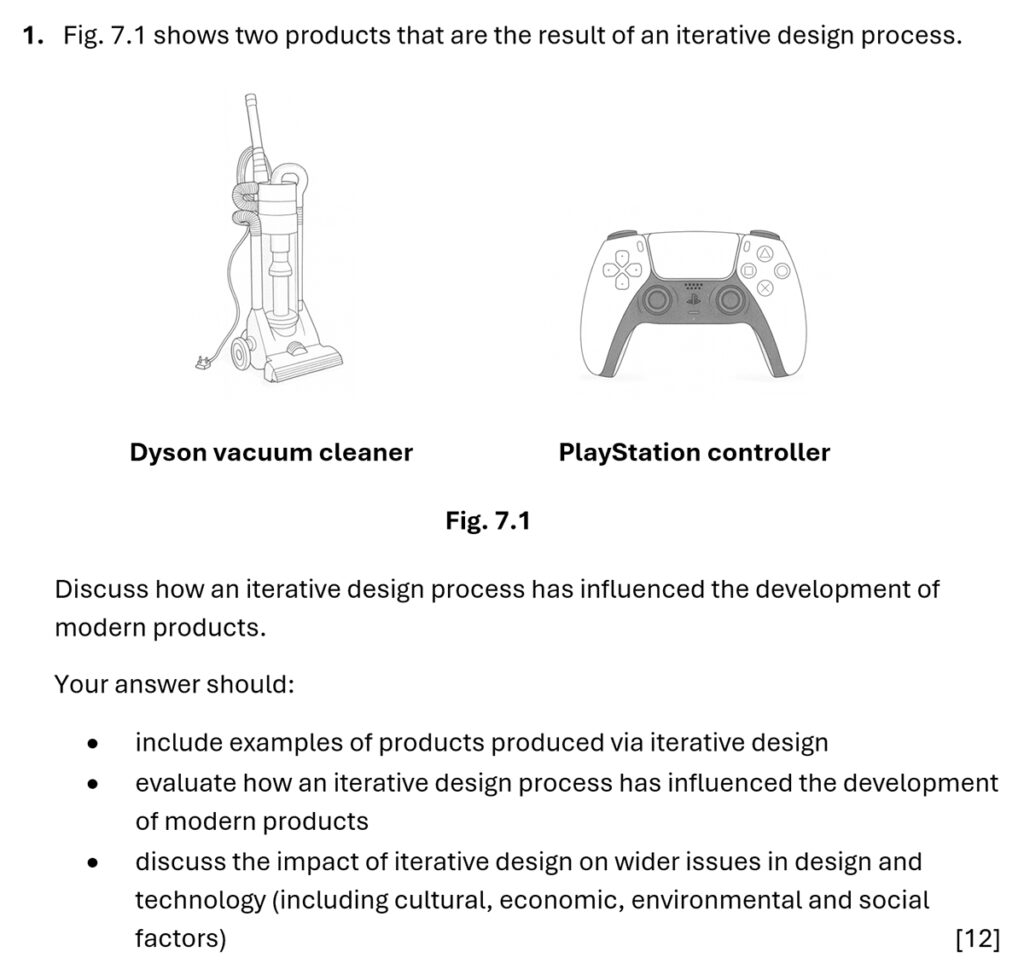
Note: Revise the iterative design process here.
Responses may include some of the following ideas, but all valid material
must be credited:
- The iterative design process has fundamentally transformed how modern products are developed, moving away from traditional linear design approaches toward cyclical methods of continuous improvement and refinement. This approach involves repeated cycles of prototyping, testing, analyzing feedback, and refining designs based on real-world performance and user experience data.
- Allows products to systematically improve over time. For example, the Dyson vacuum cleaner was the result of thousands of prototypes, with each iteration refining different aspects of the design. Similarly, PlayStation controllers have evolved over time, with each iteration incorporating user feedback and improvements in technology.
- Other notable examples of iterative design include smartphones, where companies like Apple release annual iterations that incrementally improve functionality, cameras, and user interfaces.
- Iterative design enables
- Iterative design enables more user-centered designs, that tend to be more intuitive, reliable, and aligned with actual user needs rather than designer assumptions. These leads to products that are more inclusive and accessible, with diverse user testing able to reveal needs across different demographics, abilities, and cultural contexts – leading to products that better serve community needs.
- Allows companies to respond more quickly to market demands and technological change while reducing the risk of major design failures.
- Can drive innovation and remove a fear of failure, as each product is not expected to be ‘perfect’ but a stepping stone along the journey towards a gradually improving design.
- Can have environmental benefits as products tend to be tested and work better, leading to fewer products being discarded, and more usable, high-functioning outcomes (however, repeated prototype generation can generate higher waste in the short-term).
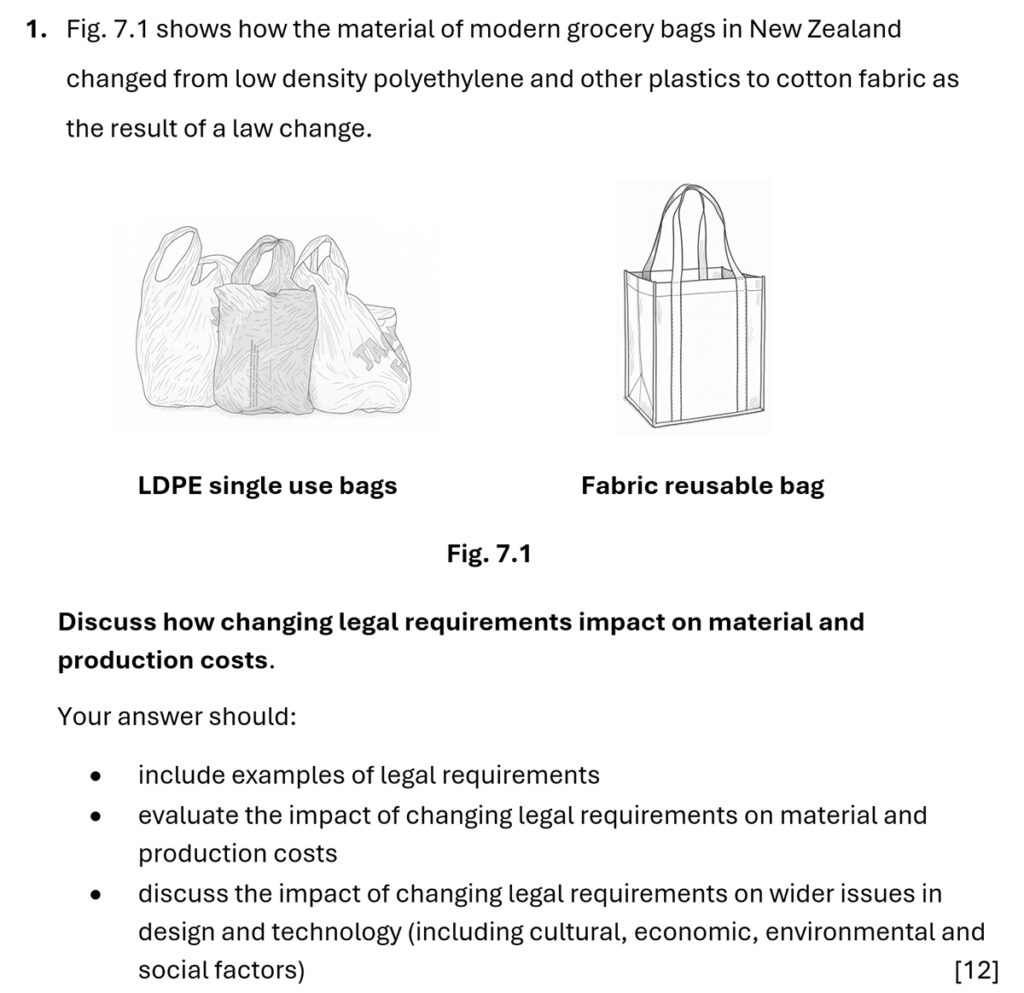
***This question was suggested by examiners as an example in the Sample Answer document.***
Responses may include some of the following ideas, but all valid material
must be credited:
- Laws are often brought in to force companies / people to change (if people would behave in that way anyway, no law is necessary). In the case of materials, such as in the case of reusable grocery bags, fabric bags are far more expensive than thin LDPE film, so companies did not want to do it (however cost over time diminishes as they are used multiple times). If a single company did this, they would be spending considerably more than their competitors, putting them at a disadvantage, which may not be financially viable (might be driven out of business). But if everyone has to do is, suddenly the playing field is levelled – no one is worse off than anyone else.
- Furthermore, when everyone has to use a new material, prices can fall, due to economies of scale. Rather than the material / item being an obscure thing that no one wants, now everyone needs it – so additional suppliers can pop up to supply that extra need, resulting in lower prices overall.
- Although laws originally ‘force’ people to change, this can result in new social norms centred around environmental responsibility and can become a visible symbol of environmental consciousness. For example, someone who used fabric bags 10 years ago might have been viewed as an unusual behavior, whereas now in NZ it is normal.
- New regulations can have different impacts on different sectors of society, with the change impacting vulnerable populations who may struggle to afford or remember reusable bags, impacting different people in different ways.
- Has other flow-on effects, affecting workers in numerous industries – disadvantaging plastic manufacturers while creating opportunities for textile producers. New business models can emerge such as customising fabric bags, and branding opportunities, where companies put their logos on reusable bags.
- Some regulations specify that materials must meet certain standards in the building industry, with rigorous checks to ensure these standards are met. If these building standards are not met, it results in significant project delays and great costs for developers, so there is significant pressure to ensure that materials and other supplies are manufactured to acceptable standards.
- New regulations can result in innovation of materials to meet new codes, demanding new inventive, better or cheaper ways of meeting regulations. It can also spur research into alternative materials like biodegradable plastics.
- Plastics in drink bottles are beginning to be regulated in some places, prohibiting certain chemicals, such as BPA
- These changes can involve significant initial investment – sometimes can be funded by government subsidies, to help ease companies into embracing change
Other possible essay question topics include:
- Discuss how intuitive design benefits the users of products.
- Many designers conduct primary and secondary research when designing products. Discuss the importance of research in product design.
- Destructive and non-destructive testing is an important part of product design. Discuss ways that destructive and testing can improve design outcomes.
- Different products are manufactured using different scales of production, including individual/one-off, batch, and mass production. Discuss factors that influence the choice of production scale, and consider when each scale of production might be appropriate.
- Discuss the ways that designs can have a positive or negative impact on society.
- Discuss the benefits of CAD and CAM for product design.
- Discuss why designers have a responsibility to ensure products are sustainable (including legal requirements, such as the new rule to eliminate single-use plastic bags in New Zealand).
- Discuss ways in which products can be manufactured so they are more readily recyclable (including the use of recycling symbols).
- Discuss the benefits of creating flat-packed products (this could be considered in terms of benefits to the manufacturer or benefits to the consumer).
- Explain why risk assessment is an essential part of product manufacturing.
- Discuss the balance of form and function in product design.
- Discuss the importance of ergonomics in product design.
- A growing number of composite materials are available to product designers. Discuss the benefits and implications of using composite materials.
- Discuss the impact of smart and modern materials on product design.
- Discuss how products can be modified to minimise their energy use across the product lifecycle.
- Discuss how different forms of energy can be used in product design (including examples of how products can convert one form of energy into another).
- Many electrical products can be thought of as a control system. Discuss the concepts of input, output, feedback, and amplification in product design.
- Discuss the impact of emerging technologies, such as AI, VR, and 3D printing on the design and manufacture of products.
